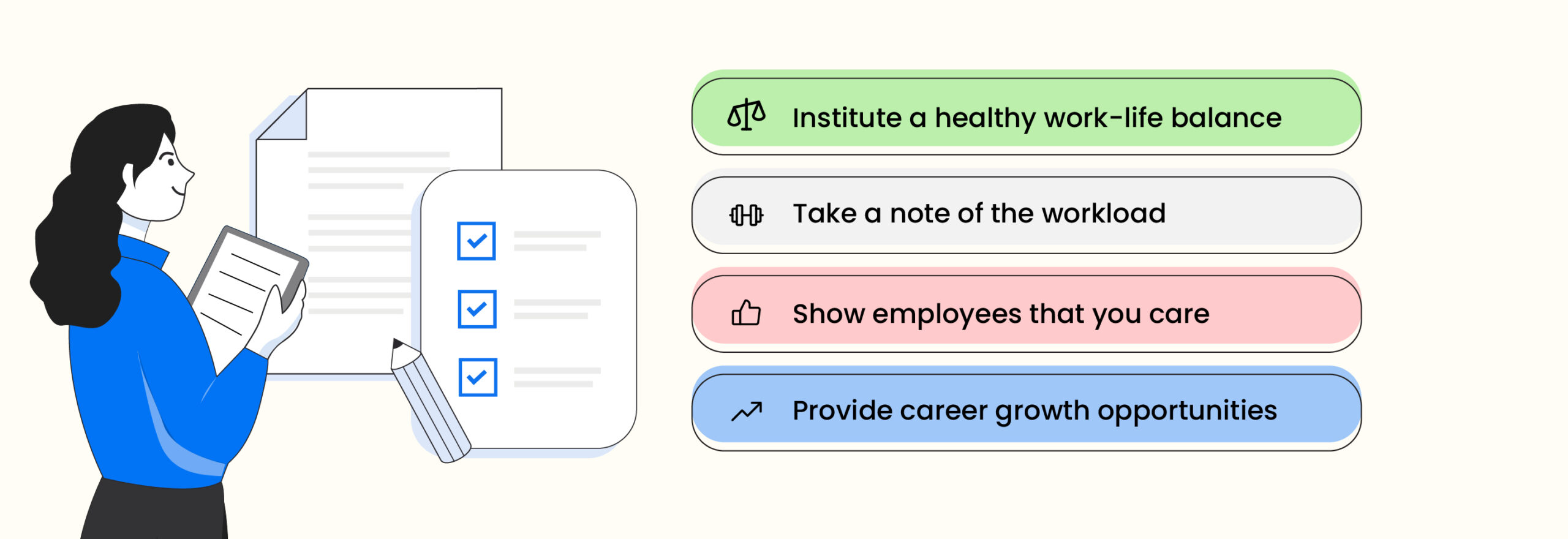The pandemic has brought about unprecedented changes in all walks of life. It had a lasting impact on how we work, and nearly two years later, the way work is continuing to evolve.
However, as organizations and HR managers across the globe gear up to reimagine the post-pandemic work culture, a new buzz phrase is spreading like wildfire.
Quiet quitting.
Naturally, the question arises – what is quiet quitting? And why should businesses take it into account at all?
This blog elaborates on quiet quitting and everything you need to know about it.
Let’s dive in!
What is quiet quitting?

If you’ve ever come across TikTok, or better yet, if you’re someone who loves to scroll through the video-sharing platform, then you know that the “Quiet Quitting” trend is ablaze on social media. The hashtag #QuietQuitting has amassed more than 17 million views on TikTok.
But what does it mean?
Quiet quitting has been around long before its recent popularity on social media. The quiet quitting phenomenon occurs when employees no longer go above and beyond for their work. It means doing exactly what’s in the job description and nothing more. For burnt-out and disengaged employees, this means doing the bare minimum to keep their paychecks coming.
How did the quiet quitting trend begin?
The quiet quitting origin story is quite interesting. It all began when Zaid Khan, a young engineer, uploaded a 17-second video on TikTok, introducing his viewers to the idea of quiet quitting.
Khan talks about how he came across the term and explained the basic philosophy behind quiet quitting. He elaborates on how quiet quitting is the antithesis of the hustle culture. But more importantly, he highlights that labor does not define your worth.
Is quiet quitting next to the Great Resignation?

The Great Resignation or the Big Quit began shortly after the Covid-19 pandemic when thousands of employees across the globe quit their jobs voluntarily.
For many people, the remote work culture spurred by the pandemic caused them to rethink what they want from their jobs.
Employees realized the importance of work-life balance and the flexibility to spend time with family and friends. Soon enough, millions of workers quit their jobs in 2021 in search of better opportunities.
The trend continued well into the first half of 2022. By the second half, the trend of quiet quitting took over, and employees were no longer doing more than they had to.
Essentially, quiet quitting is not quitting but doing enough to sustain their income until a better opportunity comes along. In a way, quiet quitting is indeed part of the Great Resignation.
Defining the ‘why’ behind quiet quitting

It all goes back to the pandemic.
Quiet quitting has been around for a long time and received its share of the spotlight during the pandemic. This is because both the Covid-19 pandemic and the Great Resignation brought power to employees and enabled them to take control of their professional and personal lives.
Among the many factors that prompt quiet quitting, the three critical ones are:
- Poor work-life balance – The remote work culture was an eye-opener to employees. It brought about a drastic realization of the importance of setting boundaries between one’s personal and professional life.
- Lack of wage growth – The inflation triggered in the aftermath of the pandemic also revealed that employees were earning relatively less. This disparity made employees realize they do not have to work so hard since they were not paid well enough.
- Disengagement – Research shows that nearly 64% of employees are disengaged at work – perhaps one of the biggest reasons for quiet quitting. Employees are motivated to work harder for organizations where they feel like they have a purpose.
Is quiet quitting good for employees?

For many people, the quiet quitting phenomenon is about drawing boundaries in their professional life for better work-life balance. This could mean not replying to work messages post 5 PM or ignoring work emails over the weekend.
However, for many others, it means just doing enough to sustain their income. And that’s where the problem lies.
Employees who stick to such a practice can often become highly disengaged. This means they are no longer ready to do what it takes to advance in their career. They may not show up, turn down projects, or show a general lack of interest in anything to do with their work.
If employees view quiet quitting as putting in next to nothing in terms of effort, it can prove to be quite detrimental to their career.
Kevin O Leary, investor, and star of ABC’s Shark Tank, says that going above and beyond is necessary to move up the feeding chain when you work for corporates. Those who become disengaged risk losing out on better opportunities, better recognition, and better pay.
What to do when you identify quiet quitting?

With the quiet quitting trend dominating a good part of 2022, it is time for organizations to rethink the employee experience.
Most quiet quitters tend to exhibit early signs, which managers need to take note of. Here are some of the common ones:
- Frequently missing meetings
- Turning down multiple projects
- Arriving quite late and/or leaving early
- Missed deadlines
- Barely meeting performance standards
- Lack of passion and initiative
- Isolation from teams and team members in general
Measures to take when your employees are quiet quitting:
If you observe any or all of the above mentioned signs with your employees, you must improve employee engagement. Here’s what you can do:
1. Institute a healthy work-life balance
Most employees lack satisfaction when they are overwhelmed with work, leaving them with barely enough time at home. Organizations must be conscious of this fatigue and take necessary steps to promote work-life balance.
2. Take a note of the workload
If your employees are overloaded with work without enough breathing space, they naturally shy away from work. Managers and businesses need to talk to employees and create a communication culture. If an employee complains about excessive work, find ways to delegate or divide the workload. Addressing such concerns and listening to employees can motivate them to do their best.
3. Show employees that you care
The employee experience is a crucial motivating factor in getting your employees to put in their 100%. Create a healthy workplace environment. Recognize employees for work well done and reward them for milestones. Open communication and valuing your employees are critical to showing employees that you care about their well-being.
4. Provide career growth opportunities
Most employees gradually become quiet quitters when they see no scope for growth or progression in their current jobs. This is why organizations need to keep upskilling their employees. It is equally essential for organizations to understand how employees wish to progress in their careers and provide them with due opportunities.
What are workers saying about quiet quitting?
Employees have a variety of reasons that seemingly justify their stance of quiet quitting.
For many employees, it is a way of getting organizations to notice all the extra effort they are putting in. For quite a while now, organizations have been used to having employees do more than expected. This means businesses are reaping benefits they are not exactly paying for. Employees resort to the quiet quitting trend to force companies to realize that they are underpaying them.
Several others use quiet quitting to find balance and reclaim their lives.
Many others feel that quiet quitting allows them to look for greener pastures while ensuring they have a steady income until they do. This is often triggered by burnout, stagnation in career, toxic management hierarchies, overall dissatisfaction, etc.
Is employee engagement the answer to quiet quitting?

From what we’ve seen so far, it is safe to deduce that disengaged employees are highly likely to turn to quiet quitting. Putting due effort into engaging your workforce can go a long way in preventing quiet quitting.
Some of the key measures include
- Understanding your employees’ challenges and mitigating them
- Creating a work culture that fosters challenging opportunities to help employees grow and flourish in their career
- Effectively capturing employee feedback and identifying areas for improvement
What can HR do about quiet quitting?

The truth is that a significant fraction of quiet quitters can be motivated to work hard. This is precisely why it is essential to understand how the people function at any organization that can prevent quiet quitting and its drastic outcomes.
Here’s what HR managers can do:
Give employees a sense of purpose
According to McKinsey, nearly 70% of people define their purpose through work. It is only natural then that employees who cannot find meaning in their work resort to the quiet quitting trend. This is why it is crucial for HR managers to regularly talk to their employees and understand their goals, aspirations, and expectations.
It is equally important for managers to ensure that employees understand how their contributions are impacting the bottom line. Awareness of how their goals tie in with the company’s overarching goals is key in helping employees stay motivated.
Recognize and reward
46% of employees say they left a job because they feel underappreciated. Motivation comes from encouragement. And it is crucial for employees to feel appreciated, especially for a job well done.
Recognizing your employees’ efforts and rewarding critical milestones boosts engagement and gives your employees a reason to stay. This could include something as simple as acknowledging their efforts at quarterly meetings.
Prevent burnout
Nearly 50% of millennials report having left a job because of burnout in their current position. Burnout can be pretty drastic for employees, affecting their personal relationships.
More importantly, burnout gives rise to employees who are too stressed and frustrated to give their best at work.
It is best to have a clear view of your employees’ workload and make provisions to cut them some slack whenever necessary. Try to incorporate flexible and accommodating work schedules and be aware of your employees’ needs and demands to prevent quiet quitting.
Value the employee experience
Employees who feel that a company is going above and beyond to implement a great employee experience are highly likely to be loyal to the company.
Employee experience is underrated. But it is critical to increasing employee engagement. Build a healthy work culture that respects your employees’ well-being. Provide them with health benefits and other valuable perks to your employees.
To Sum Up
Quiet quitting is a significant issue that may have a severe influence on both businesses and people. Even though the practice of ‘quiet quitting’ is not as new as it has been made out to be, it is a trend that is on the rise, and if it is not anticipated and preventive measures are not implemented, it will become a more significant problem for the organization, as the next step after ‘quiet quitting’ would be for the employees to find a new role elsewhere and officially resign from their current position.
Proactive employee engagement is essential, and measures to reduce employee difficulties in the workplace must be implemented. Finally, silent resignation answers the question, “How are you demonstrating that you care about your employees?” Employees want to know they are supported daily and that their firm cares about their well-being.
The only remaining issue is if you are prepared to improve your employee experience. Schedule a demo with Leena AI’s automation specialists to learn about the new age of exceptional employee experience.
Build Intelligent Employee Engagement with Leena AI
Schedule a demo todayFrequently Asked Questions
What is quiet quitting work?
Quiet quitting work is the habit of opting out of tasks that are outside of one’s obligations and performing the bare minimum of one’s work requirements. Following the epidemic, a rising number of workers have begun to follow this practice at their workplace after believing that their employer does not recognize their efforts and does not provide adequate recompense for extra hours put in.
Is quiet quitting a Real Thing?
Quiet quitting has recently gained popularity among employees who are only there for the salary and are not emotionally or intellectually engaged. It’s all about doing the absolute minimum rather than going “above and beyond.” Some, though, are skeptical that the trend exists at all.
How do you keep an employee who is leaving?
Employers and managers can help avoid or reduce this practice by promoting good workplace management practices. The first step in preventing silent resignation is to establish the greatest workplace culture and atmosphere for your employees, give them an opportunity for your employees to express their issues without fear of being fired or chastised, and listen to what they are saying. Listen to their concerns without bias or preconceptions, and then address the issues they have highlighted to demonstrate that their opinions count and that they are respected and supported as workers.
What are the signs of quiet quitting?
Most quiet quitters show early indicators, which managers should be aware of. Here are some of the most common:
- Meetings are frequently missed.
- Rejecting many projects
- Arriving late and/or departing early
- Deadlines were missed.
- barely meeting performance expectations
- a lack of enthusiasm and initiative
- Isolation from teams and, more broadly, team members






